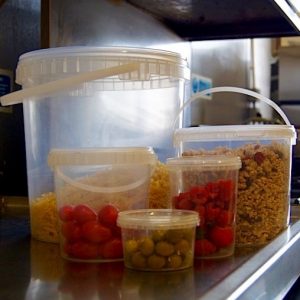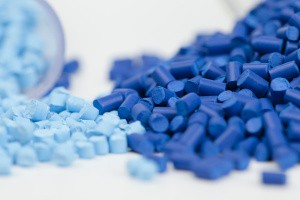The Local Government Association (LGA) has called for legislation requiring all restaurants and takeaway outlets in England to display their food hygiene scores prominently to customers.
The organisation that represents councils in England said that the rule should be introduced as part of post-Brexit trade legislation.
Currently, local authorities carry out hygiene inspections on all businesses that prepare and sell food and publish the results on the internet, but English restaurants and takeaways are under no obligation to display the food hygiene ratings.
The mandatory ‘Scores on the Doors’ legislation is already in place in Wales where it demonstrates hygiene standards to the paying public.
H&O Plastics has produced a colour coded cleaning poster to help hospitality clients ensure that proper hygiene measures are followed in sensitive environments.
 H&O Plastics supply plastic buckets to hundreds of hygiene-conscious catering firms every year.
H&O Plastics supply plastic buckets to hundreds of hygiene-conscious catering firms every year.
Because we manufacture all our own products, it puts us in a unique position to be flexible around client demands.
We can create and deliver high-quality containers in dozens of different styles, sizes, and importantly, colours.
Colour-coding is an integral part of any kitchen’s hygiene policy, and because we can deliver small-batch orders in lots of different colours, it makes us valuable supply partners for caterers.
Colour-coordinating your cleaning products helps prevent cross-contamination in sensitive environments.
Designating certain coloured products to certain areas (such as red cleaning products in washrooms) helps prevent the spread of germs into food preparation areas.
You should try to source different coloured cleaning products like brushes, cloths and, of course, buckets and put strict policies in place to prevent staff from cross-contaminating surfaces.
You may wish to designate your own colours to specific operations or processes. For example, if you operate a bar, you may want to designate specific colours for carrying ice and, if you run a restaurant, you may wish to designate certain colours to store certain types of food.
Our flexibility around bucket colour has helped in different ways too. Customers in the chemical industry, for example, use different coloured containers to distinguish between harmful and non-harmful products.
This is critical in this industry because it means that containers can be sent to foreign countries where certain handlers may not be able to read attached labels.
 Good food storage is integral to passing your ‘Scores on the Doors’ inspection. H&O Plastics sell a special range of clear plastic food storage containers in different sizes to help caterers prepare food ahead of time and store it hygienically.
Good food storage is integral to passing your ‘Scores on the Doors’ inspection. H&O Plastics sell a special range of clear plastic food storage containers in different sizes to help caterers prepare food ahead of time and store it hygienically.
The containers are all made from food grade plastic, meaning they meet international standards for the safe storage of food.
The containers also have lids, so you don’t have to have uncovered food in storage areas and you can better ensure that there is no cross-contamination between foods. These lids are tamper evident meaning that they can be sent out to customers or third parties while retaining the product’s integrity.
For more information on food grade plastics please speak to a member of our accounts team. Call: 0151 639 0002
 Plastic waste is a growing concern in Britain and around the world. Global demand for plastics is expected to double in the next 20 years, but most plastic packaging is only used once before it is discarded and only about 14% of plastic packaging is collected for recycling.
Plastic waste is a growing concern in Britain and around the world. Global demand for plastics is expected to double in the next 20 years, but most plastic packaging is only used once before it is discarded and only about 14% of plastic packaging is collected for recycling.
40% of the globe’s plastic winds up in landfill and about a third of it leaks out into delicate ecosystems.
It is estimated that a dumper truck full of plastic enters the world’s oceans every minute.
Governments, industry and consumers are starting to wake up to their responsibilities over plastic waste. New legislation has been introduced, companies like supermarkets are rethinking their plastic policies and more and more consumers are voting with their feet for greener companies.
Businesses in the food and drink service sector are responsible for a significant proportion of plastic packaging waste. Restaurants, bars, takeaways and coffee shops waste millions of tons of containers, straws and plastic water bottles every year.
Here are three things that your food service company can do to limit the amount of plastic it wastes.
When thinking about how we reduce plastic waste, most people think about recycling. It is better, however, if we can find ways to never produce the plastic in the first place.
Purchasing products and packaging that can be re-used is one of the best ways of achieving this.
 Single use plastic containers that are thin and liable to snapping are a real blight on the environment. Businesses are often not comfortable using these more than once, especially if they are low quality plastics and are liable to ‘leeching’ into food products.
Single use plastic containers that are thin and liable to snapping are a real blight on the environment. Businesses are often not comfortable using these more than once, especially if they are low quality plastics and are liable to ‘leeching’ into food products.
Professional kitchens and other food businesses should purchase food-grade plastic containers that are manufactured with more raw material, are more durable and less prone to cracking.
Takeaways that send food out in plastic containers can do their bit by using higher quality containers. Not only do these make your takeaway look more professional, but they are also more likely to be re-used by customers, minimising immediate impact on landfill.
Why not try swapping your thin plastic containers for these sturdy round plastic containers.
Fast food establishments, restaurants and bars are all guilty of offering plastic drinking straws when they are not necessary.
In America alone, an estimated 500 million plastic straws are used and discarded every day. Straws are a particular environmental hazard if they end up in sensitive ecosystems. Partially broken-down straws can end up lodged in nostrils of sea turtles or fill up the stomach of a penguin.
Several pub and bar groups have made headlines by announcing plans to phase out drinking straws – either by training staff to not offer straws as standard, replacing plastic straws with sustainable alternatives or banning straws altogether.
Often it isn’t just straws either. Coffee shops can reduce their environmental impact by tackling coffee cups, lids and stirrers – either by encouraging customers to bring a reusable cup or by offering recyclable alternatives.
It is important that you find out how much waste your food service business produces. Try conducting a waste audit to figure out how much plastic, food and other materials you throw out each year and think about ways that you can tackle this.
Remember, as well as saving the planet, you can also save cash on waste disposal services and the cost of buying products like straws in the first place.
One of the biggest plastic waste culprits is the single use water bottle. In the UK we use over 35 million plastic bottles every year. Plastic water bottles are rarely re-used, but research suggests that 7 in 10 Brits feel embarrassed about asking for tap water when we aren’t asking for something else.
Food and drink service companies can help combat single-use plastic bottles by actively promoting tap water, encouraging people to bring their own reusable bottles of water into your business and/or refilling water bottles on request.
We have produced a new colour coded cleaning poster to help caterers and other clients in the hospitality industry ensure proper hygiene measures are followed. Please feel free to download and print the poster and display it in your place of business.
At Buy Buckets we manufacture and distribute all of our own products. This puts us in a unique position to be flexible around client demands.
We have the capacity to create and deliver containers of different styles, different sizes and different colours. This flexibility is extremely valuable to some of our clients because it allows them to get exactly what they want every time.
Even if a product isn’t advertised on our website there are instances when we can produce a container in a different colour or to a different specification based on what the customer needs.
In the past, we have experimented with different coloured polymers to help get plastic containers to better reflect a brand’s colours.
Our flexibility around bucket colour has helped in different ways too. Customers in the chemical industry, for example, use different coloured containers to distinguish between harmful and non-harmful products.
This is important because these products can be sent to foreign countries where handlers might not be able to read attached labels.
The ability to get plastic containers in different colours opens up a number of new opportunities for our clients.
Customers in the catering industry can use this downloadable colour coded cleaning chart to help ensure a hygienic environment when serving food and drink.
Colour coordinating your cleaning products helps to prevent cross contamination between different sensitive areas.
The idea is that you designate a particular area (such as the washrooms) to a particular colour (such as red). Failing to do this could lead to you sharing germs between your toilet bowl and your food preparation areas, which is unsatisfactory.
The downloadable chart is self-explanatory with distinct colours for each area. You should source cleaning products like brushes, cloths and of course buckets in these colours and only use these colour coded items in the designated area.
You may also wish to designate your own colours to other particular operations or processes. For example, if you operate a bar you might wish to designate a separate colour for carrying ice or if you operate a restaurant you might wish to designate colours for storing different types of food.